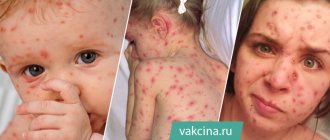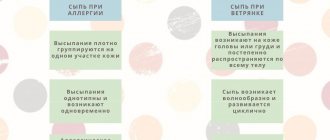2018-01-09
- Source
- Manifestations
- Complications
- Vaccines
Chickenpox (varicella, chickenpox) is an acute and highly contagious disease. It is caused by a primary infection with the varicella zoster virus. Varicella outbreaks occur throughout the world and, in the absence of a vaccination program, affect a large proportion of the population by mid-life.
When did chickenpox start?
Chickenpox has been known since ancient times. For some time it was considered a mild form of smallpox, and only in 1772 was it identified as a separate disease. And in 1909, it was found that chickenpox and shingles have the same pathogen, which was later confirmed by laboratory tests. Subsequent study of the virus led to the development of a live attenuated varicella vaccine in Japan in the 1970s. The vaccine was licensed for use in the United States in March 1995.
Complications
According to statistics, complications are observed in 5% of cases of chickenpox. They are more often diagnosed in pregnant women, infants and people with weak immune systems. Complications can be caused by exposure to the virus itself or by the addition of a bacterial infection, and in the first case, damage to any organs and systems of the body is possible. Possible complications.
- Bacterial origin - phlegmon, abscess, erysipelas, sepsis.
- Herpetic origin - laryngitis, tracheitis, pneumonia.
- Associated with disruption of the nervous system - encephalitis, cerebral edema, paresis and paralysis of muscle fibers.
- Associated with damage to the cardiovascular system - myocarditis, thrombophlebitis.
- Pathologies of muscles and joints – arthritis, myositis.
What causes chickenpox and how can you get infected?
Varicella zoster virus (VZV) is a virus that causes chickenpox and belongs to the herpesvirus family. Like other viruses in this group, it has the ability to persist in the body after the initial infection.
After a person has had chickenpox, VZV does not leave the body but remains in the sensory nerve ganglia.
Thus, primary VZV infection leads to chickenpox, and herpes zoster is the result of reactivation of a latent infection of this virus, which is caused by decreased immunity due to various circumstances (hypothermia, stress, etc.) or concomitant diseases that are accompanied by immunodeficiency (malignant blood diseases, HIV etc.). Due to the presence of this property, the chickenpox virus belongs to the group of pathogens of slow infections. It is worth noting that the chickenpox virus itself has an immunosuppressive property.
VZV is thought to have a short survival time in the environment. All herpes viruses are sensitive to chemical and physical effects, including high temperature.
The source of infection is a person with chickenpox or herpes zoster. The virus is contained on the mucous membranes and in the elements of the rash. A patient is considered contagious from the moment the rash appears until crusts form (usually up to 5 days after the last rash).
The chickenpox virus is highly contagious, meaning it is very likely to be transmitted through respiratory droplets or direct contact with characteristic skin lesions of an infected person. This is due to the fact that most of the population becomes ill in childhood.
80-90% of cases occur under the age of 14 years. Chickenpox is also characterized by high susceptibility (90-95%).
Most countries tend to have higher incidence rates in urban areas (700-900 per 100,000 population) and significantly lower rates in rural areas. The epidemiology of the disease differs in different climatic zones, for example, a significant difference is observed in temperate and tropical climates. The reasons for these differences are poorly understood and may relate to properties of the virus (which are known to be heat sensitive), climate, population density, and exposure risk (eg, daycare or school attendance, or number of siblings in the household).
Why is chickenpox so relevant in the modern world?
The relatively mild course and low mortality rate have long been the reason for an extremely calm attitude towards this infection.
However, at the moment, as a result of numerous studies, it has been established that the pathogen can affect not only the nervous system, skin and mucous membranes, but also the lungs, digestive tract, and genitourinary system.
The virus has an adverse effect on the fetus when the disease occurs in pregnant women. It is worth remembering that the mother can transmit the infection to the fetus if she is sick with chickenpox or herpes zoster (the virus can penetrate the placenta throughout pregnancy).
Treatment
Chickenpox usually goes away in 7-10 days . The main action during therapy is treatment of the rash to prevent suppuration. Brilliant greens, potassium permanganate, etc. are suitable for this. To relieve unpleasant symptoms, the child may be prescribed antihistamines and antipyretics.
During the course of the illness, it is not recommended to use a washcloth and soap. Dress your child only in soft cotton clothes to reduce itching and the likelihood of rupture of the blisters.
Throughout the entire period of illness, the child is isolated at home, in the children's room. A kindergarten or school is quarantined for three weeks.
What are the manifestations of chickenpox (chickenpox)?
The chickenpox virus enters through the respiratory tract and conjunctiva. It is believed that the virus multiplies in the mucous membrane of the nasopharynx and regional lymph nodes.
The initial entry of the virus into the blood occurs a few days after infection and contributes to the entry of the virus into the epithelial cells of the skin, where further reproduction of the virus and corresponding skin changes occur.
Then a secondary entry into the blood . It should be remembered that not only the skin epithelium can be affected, but also the mucous membranes of the gastrointestinal tract, respiratory tract, and genitourinary system. Considering that the virus is tropic to nervous tissue, degenerative and necrotic changes can develop in the nerve ganglia, sensory nerve roots and spinal cord.
Incubation period . The period from the virus entering the body to the onset of clinical manifestations ranges from 5 to 21 days after exposure, usually 1-2 weeks. The incubation period may be longer in immunocompromised patients.
Infected people may have a mild prodrome that precedes the onset of the rash. In adults, this may be 1 to 2 days of fever and malaise, but in children, a rash is often the first sign of illness.
The onset is most often acute . Fever lasts 2-7 days, longer in severe cases. Patients complain of an itchy rash, body aches, decreased appetite, sleep disturbance, and headache. Nausea and vomiting may occur.
The first elements of the rash appear on the face and torso, and then on the scalp and extremities; The greatest concentration of lesions is on the torso with the appearance of rashes within 4-6 days. In this case, elements of the rash are present at several stages of development (for example, redness and papules can be observed simultaneously and in the same area as vesicles and crusts).
The rash can also occur on the mucous membranes of the oropharynx, respiratory tract, vagina, conjunctiva and cornea.
The rash elements usually have a diameter of 1 to 4 mm. Vesicles (bubbles) are superficial, single-chambered and contain clear liquid, surrounded by a red rim. Over time, they dry out and turn into crusts, after rejection of which temporary pigmentation and occasionally small scars remain.
The number of rash elements ranges from single to multiple. The vesicles may rupture or fester before they dry out and take on a crusty appearance. The rash is accompanied by severe itching.
In 20-25% of patients, rashes may occur on the mucous membranes of the mouth and gums. Usually they quickly open, form erosions and are accompanied by pain, burning and increased salivation.
About 2-5% of patients have elements of a rash on the conjunctiva.
Also, with chickenpox, as a rule, the lymph nodes (submandibular, cervical, axillary, inguinal) become enlarged.
Recovery from the initial chickenpox infection usually results in lifelong immunity. But recently, cases of recurrent chickenpox have become increasingly common. This is not common in a healthy person, and most often occurs in immunocompromised individuals.
What complications can occur with chickenpox?
The disease is usually mild, but complications may occur, including bacterial infections (eg, bacterial skin lesions, pneumonia) and neurological infections (eg, encephalitis, meningitis, myelitis), which can be fatal.
Secondary bacterial skin infections , which are caused by streptococcus or staphylococcus, are the most common cause of hospitalization and outpatient medical visits. Secondary infection with invasive group A streptococci can cause abscesses and cellulitis.
Pneumonia after chickenpox is usually viral, but can also be bacterial. Secondary bacterial pneumonia is more common in children under 1 year of age. It is characterized by an increase in temperature up to 40⁰C, an increase in pallor and cyanosis of the skin, the appearance of a substernal dry cough and shortness of breath. Patients can take a forced position in bed.
Damage to the central nervous system in chickenpox ranges from aseptic meningitis to encephalitis. Cerebellar involvement followed by cerebellar ataxia is the most common presentation of central nervous system disorders but usually has a positive outcome.
Encephalitis is one of the most dangerous complications of chickenpox (10-20% of cases are fatal). This complication manifests itself as headache, nausea, vomiting, convulsions and often leads to coma. Diffuse brain involvement is more common in adults than in children. Chickenpox meningitis may occur together with encephalitis or independently .
Rare complications of chickenpox include Guillain-Barré syndrome, thrombocytopenia, hemorrhagic and bullous chickenpox, glomerulonephritis, myocarditis, arthritis, orchitis, uveitis, iritis and hepatitis.
Once infected, the virus remains hidden in nerve cells and can be reactivated, causing a secondary infection, herpes zoster. It usually occurs in adults over the age of 50 or with a weakened immune system and is associated with a painful rash that can cause permanent nerve damage.
What is herpes zoster?
Herpes zoster (shingles) occurs in people as a manifestation of the reactivation of a latent infection caused by a virus that was in the nerve ganglia after chickenpox. The localization of subsequent rashes will depend on which nerve ganglion the virus (VZV) was in a latent (dormant) state.
Localization of the rash in case of damage to the trigeminal nerve ganglion - on the scalp, in the forehead, nose, eyes, lower jaw, palate, tongue; if the virus is present in the spinal ganglia - on the neck, trunk, upper and lower extremities.
Features of the rash with herpes zoster are:
- vesicles are located on the skin in groups along the corresponding nerve,
- the disease most often begins with pain, followed by redness and corresponding rashes,
- over time the pain becomes less and less,
- the process is always one-sided,
- Usually the rashes are accompanied by fever, malaise, and weakness.
Soothing baths
Many parents are concerned about the question: How to relieve itching with chickenpox in children? In order to eliminate this symptom, it is recommended to use herbal baths to soothe the skin.
Recipes:
- Crushed celandine (50 grams) must be added to boiling water (800 ml). Boil the solution for 5 minutes. The infected person should be bathed using the product received. You need to repeat the procedure in the morning and evening. Effectively helps relieve severe itching.
- Add baking soda (100 grams) to slightly warm water. The patient should bathe in the bath for at least 10 minutes. Repeat therapy every 4-6 hours.
- Mix dried yarrow (150 grams) with 5 liters of boiled water. Leave the solution for 4 hours. The resulting solution must be added to the bath in which the patient must bathe. The duration of the procedure is 20 minutes.
Read also: Does lichen itch in humans: what types, symptoms, treatment
The above methods will help to quickly and effectively relieve itching from chickenpox in a child. Treatment is necessary until the unpleasant symptom completely disappears.
What methods exist for diagnosing chickenpox?
Usually the diagnosis is made on the basis of the clinical picture and an objective examination of the patient.
To confirm the diagnosis using laboratory methods, blood, cerebrospinal fluid, and the contents of vesicles and pustules are taken. Microscopy is used as an oriented method.
In modern practice, serological diagnostic methods are used (ELISA, RSK, RNGA, RIA). In this case, blood is taken twice: at the beginning of the disease and during the period of convalescence. The reaction is considered positive if the antibody titer increases 4 times or more.
It is worth noting that ELISA and PCR are the most commonly used. There is also a method for cultivating the virus, but due to labor intensity and high costs, it is not currently used.
How to treat chickenpox?
Patients with an uncomplicated course are most often treated at home. Elements of the rash are treated with a concentrated solution of potassium permanganate. The oxygen that is released as a result of this prevents the addition of a secondary infection and also reduces itching. For a small number of rashes, you can use brilliant green.
Only in severe or complicated cases is treatment directed at the pathogen necessary. These are drugs acyclovir, valacyclovir, famciclovir, which can only be taken after consulting an infectious disease specialist or family doctor. Antiviral treatment is mandatory for herpes zoster. Local application of acyclovir ointments is also possible.
If the itching is severe, those with chickenpox should take antihistamines. For severe pain in patients with herpes zoster - analgesics. If there is a high temperature and severe intoxication, detoxification therapy (intravenous administration of certain solutions) is indicated. Immunoglobulin is indicated for persons who have a reduced level of immunity.
Ointments and creams for topical use for itching from chickenpox
In this section of the article we will answer the question: “How to relieve itching in a child with chickenpox?” Many doctors prescribe ointments or creams for young children with this disease, as they do not cause side effects. The safest ointment for itching with chickenpox is zinc. It helps speed up the healing process of skin rashes, dries them out, relieves irritation and soothes the skin. The drug is applied to the skin several times a day. It can be used both in childhood and in adulthood.
How to prevent chickenpox?
Chickenpox can be prevented through vaccination. Specific prevention is carried out with live vaccines from a weakened varicella zoster virus (for example, the Belgian vaccine Varilrix). Vaccination is especially recommended for young children, and in the United States for the elderly, to prevent herpes zoster and postherpetic neuralgia.
In clinical trials, it was found that individuals who were vaccinated were either not susceptible to chickenpox or experienced it in a very mild form.
Chickenpox vaccines
Vaccination is necessary for those categories of people who have reduced immunity and, as a result, a high risk of severe and complicated course of the disease. These include the following categories:
- persons with malignant diseases,
- HIV-infected,
- those groups of people who have severe chronic pathology,
- patients taking glucocorticosteroids.
Vaccination indicated:
- for preventive purposes, especially recommended for high-risk categories: - routine vaccination at the age of 12-15 months, - routine second dose at the age of 4-6 years.
- for emergency prevention of those who have not had chickenpox and have not been vaccinated, but are in contact with patients.
The minimum interval between doses of varicella vaccine is 3 months for children under 13 years of age.
Although single-dose programs are effective in preventing severe varicella disease, as demonstrated by a study in Australia (one of the few countries to include varicella vaccination as part of its national immunization program), evidence suggests that it is not necessary to interrupt transmission of the virus. two doses are required. Emerging school outbreaks and high rates of chickenpox, although usually not severe, have prompted some countries to implement a two-dose vaccination schedule.
Vaccination is the most effective medical intervention ever invented by man.
Used materials
- https://www.cdc.gov/vaccines/pubs/pinkbook/varicella.html - etiology, pathogenesis, clinical features, prevention of chickenpox
- https://www.who.int/immunization/sage/meetings/2014/april/5_The_potential_impact_Varicella_vaccination_Low_Middle_Income_Countries_feasibility_modeling.pdf?ua=1&ua=1 – vaccination for chickenpox
- https://www.who.int/immunization/diseases/varicella/en/ - about the epidemiology of chickenpox and herpes zoster
- https://www.who.int/bulletin/volumes/92/8/13-132142/en/ - research on the effectiveness of vaccination against chickenpox and herpes zoster in Australia.
- https://www.who.int/immunization/position_papers/varicella_grad_effectiveness_2_doses.pdf?ua=1 - about the effectiveness of vaccination against chickenpox.
- https://www.who.int/wer/2014/wer8925.pdf?ua=1&ua=1 – epidemiology, diagnosis, treatment, some positions on vaccination for chickenpox and herpes zoster.
- Vozianova Zh. I. Infectious and parasitic diseases: In 3 volumes - K.: Health, 2000. - T. 1. - 904 p.
- Golubovskaya O. A. Infectious diseases. - M.: VSV "Medicine", 2012. - 728 p. + 12 s. color. on
Author: Anastasia Lishnevskaya, infectious disease doctor Source: MMK Formed
Anti-anxiety therapy
Due to severe and painful itching, children become nervous and capricious. To keep the baby calm and not scratch the papules, the doctor prescribes medications that have a beneficial effect on the nervous system: “Valerianahel”, “Leovit” jelly, “Phenozepam” or “Phenibut” drugs, homeopathic granules “Shalun”. The homeopathic drug “Nervohel” gives good results, which helps to calm the child during illness. It comes in tablet form. They need to be absorbed under the tongue, so the product is recommended for older children. Children over three years of age are prescribed one tablet three times a day.










